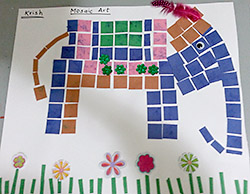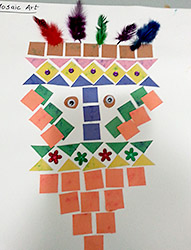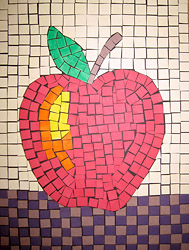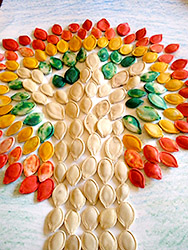
Introduction to mosaics

Traditional mosaics are beautiful works of art. They are created with many small pieces of clay, glass, stone and other hard materials, which are set closely together on a firm surface to create a decorative design or picture.
The earliest mosaics date back to 3000 B.C. when they were usually created as a type of floor decoration made of small colored pebbles. Later, glass, marble and clay were colored and then cut into small cubes or tiles. These were used to decorate the floors, walls and ceilings inside important buildings. A thick layer of plaster would be applied to the wall, then a picture or design was painted on to the surface while it was still wet. Before the plaster dried, matching colored cubes or tiles were pushed into the surface to create the mosaic.
Large mosaics took a long time to make and were expensive, so they were precious and a sign of wealth. They were mostly used to decorate the inside of churches and religious buildings. Early Christian mosaics show figures and animals with decorative borders. In Islam, temples were decorated with beautiful designs of leaves and palm trees with a vibrant gold background. The Greeks often decorated their floors with dark and light pebble mosaics. The ancient Egyptians made mosaic jewelry for their kings. Some early mosaics can still be seen today, as they have not worn away over time.
Materials
You can use some basic materials to create mosaic at home. Mosaic can be created using many different small objects from home such as card paper, felt paper, marble paper, pebbles, eggshells, pasta, chains, screws, washers, nuts and bolts. You can use mosaic for making greeting card, an African mask, on any bag, make necklaces, coaster, picture frame, decorating pot or a book cover; even you can decorate your cookies with mosaic art.
Indian elephant design on bag
In India, elephants are often seen at festivals wearing bright, colorful decorative saddlecloths and elaborate headdresses. Using colored felt or fabrics, feathers and pretty gold or metallic colored trims, you can create a fabric Indian elephant mosaic on a plain bag.
- Cut gray felt into small squares and wedge shapes.
- Transfer the elephant design on your bag. Stick the grey felt squares and wedge shapes on to the elephant’s body using PVA glue.
- Use different colors and cut some more felt into small squares and wedge shapes. Glue them for elephant’s colorful decorative saddlecloths.
- Use PVA glue to attach small feathers to the headdress, and use sequins to decorate the saddlecloth.
- Glue metallic colored trim around the headdress and the base of the saddlecloth.
Note: The design on this bag is only glued on and therefore the bag should not be washed. If it gets dirty, carefully sponge it clean.
Art competition
- Create any design using mosaic art and send in your entry by Aug. 15.
- You can also make our Indian flag using mosaic as our Independence Day is coming soon.
- Be creative. Use different materials and create your own mosaic.
- Winner’s name will be announced in September issue.
Remember: When it’s from HEART, its ART
Shyama Rangwala can be reached at (813) 843-6784, e-mail [email protected] or visit www.shyamshyama.com or check Shyama’s Art on Facebook.





